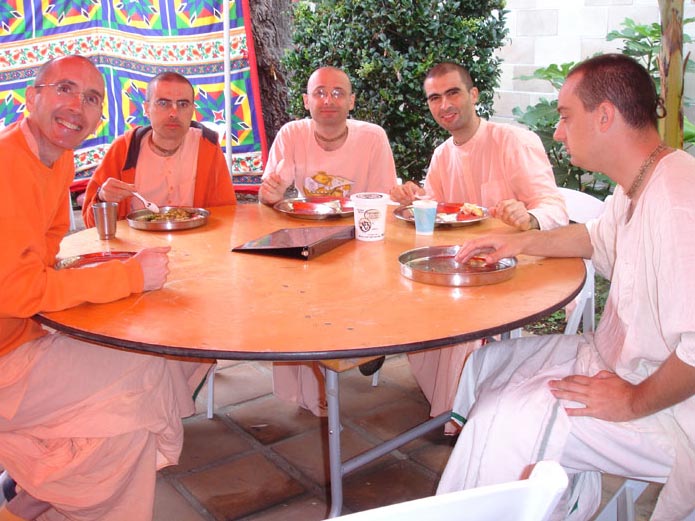First Brahmacari Conference Held In San Diego
By Madhava Smullen | Jan 03, 2009

Last September saw the first ever US Brahmacari Conference held at San Diego’s ISKCON temple.
In the Gaudiya vaishnava culture followed by ISKCON devotees, four stages of life are central to a regulated devotional life: Brahmacarya, wherein the celibate student is trained in discipline and respect; Grihasta, wherein the householder raises a Krishna conscious family; Vanaprastha, wherein the older married couple focus more on spiritual life and prepare themselves for renunciation; and Sannyasa, or complete renunciation.
Many believe that the spiritual success of a Krishna conscious society is founded on how strongly the principles of the first stage, brahmacarya, are taught. The Brahmacari Conference was born when Prahladananda Swami at ISKCON’s Sannyasa Ministry, as well as many other senior leaders, felt an increasing need for brahmacari training forums.
Forty to fifty devotees, mainly brahmacaris, attended the conference, although school teachers, temple presidents, householders and leaders also attended. Presenters Danavir Goswami, Bhakti Vikasa Swami, and Candramauli Swami were accompanied by ISKCON book distribution minister Vijaya Dasa and BBT editor Dravida Dasa, who taught book distribution and verse memorization techniques respectively.
Danavir Goswami focused on topics from Brain Gain, his book on the benefits of celibacy. In Celibacy: Scientists See the Light, he discussed different discoveries by scientists about the benefits of celibacy. Next came Celibacy: The Freud Fraud, followed by Celibate Geniuses and Diet, showcasing an impressive list of geniuses throughout history who were all celibate.
Bhakti Vikasa Swami’s first topic, Brahmacarya in an Age of Diminished Authority: Sexual Promiscuity, Feminism and Homosexuality tackled the problem of trying to be celibate in a sex-obsessed society. Next, in To Marry or Not to Marry? He opened up the floor for discussion on this important question for celibate students. The remaining time after his third topic, Inner life: Highest Realization or Lowest Degredation was used to deal with other issues relevant to brahmacaris today.
The final speaker, Candramauli Swami, first discussed Srimad-Bhagavatam 5.14, “The Forest of Enjoyment.” This famous chapter contains allegories to show material life as it is, stripped of all its sheen. Next the Swami spoke on Money and Women, the attraction to which are two of the most common obstacles on the path to brahmacari life. His last topic, using teachings from the Bhagavad-gita, was The Mind: Best Friend or Worst Enemy?
Brahmacari and San Diego temple president Maha Tattva Dasa says the conference was a success. “It helped devotees look at brahmacari life from a more mature perspective, and left everyone feeling more encouraged and enthused about the lifestyle. And of course, it gave brahmacaris the opportunity to meet, exchange thoughts and experience being part of a group.”
Maha Tattva says that with the kind of challenge being celibate in today’s society brings, these kind of support groups and training are very important.
It’s also important to remember the benefits of receiving brahmacari training at some point in life. “Training as a brahmacari teaches us to be passionate about Krishna consciousness, to go deeply and sincerely into it,” he says. “One learns to be respectful, detached, humble and missionary. And of course, a good brahmacari makes a good householder – somebody who is respectful, able to control the senses, and devoted to serving Krishna.”
ISKCON’s Sannyasa Ministry aims to continue holding annual brahmacari conferences in late September, on both the east and west coasts of the United States.















